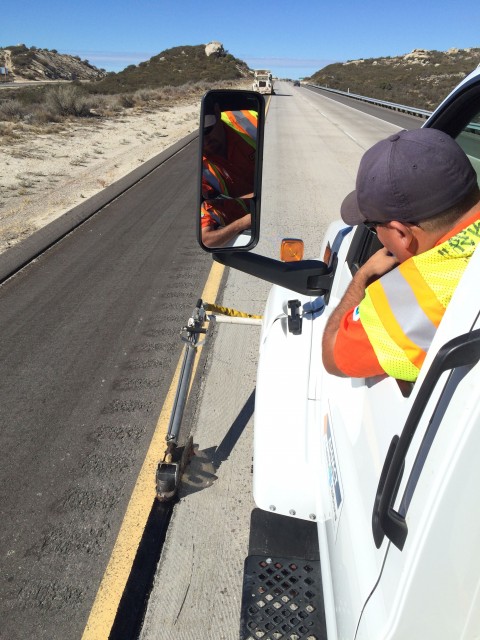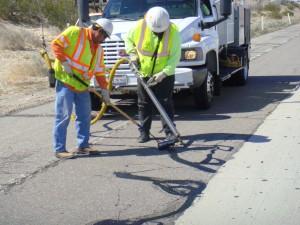
![]()
Sealzall - Automated High Production Crack Sealing
Link to pdf here.
| Outcome | The introduction of innovative crack sealing equipment capable of high production automated longitudinal sealing and enhanced manual in-lane crack sealing operations into Caltrans statewide Maintenance operations. |
| Benefit | Dramatic increases in both production and safety for highway pavement sealing operations, while also reducing traffic obstruction. |
Sealzall Viejas Drive By. (High Resolution 73 MB)
AHMCT researchers have successfully completed field trials of the newest generation of automated crack sealing machine. The Sealzall sealing prototype was operated by Caltrans District 11 crews for a one year trial period where the machine provided a six fold increase in longitudinal sealing production rate while eliminating worker traffic exposure for unparalleled worker safety benefit. Sealzall longitudinal sealing operations are conducted exclusively in moving lane closures since this operation is continuous, fast moving, and no workers are directly exposed to traffic on the highway. This feature also reduces traffic obstruction and enables the unprecedented sealing across highway ramps using a quick rolling closures. The Sealzall has been developed with a front-mounted multi-purpose heated hose and manual wand assembly which enables this equipment to be quickly configured for any type of crack sealing operation on the highway
Longitudinal Sealing Operations
The Sealzall is a fully self-contained vehicle designed to dispense rubberized hot applied sealants from an on-board 400 gal oil jacketed kettle. When configured for longitudinal crack sealing, the Sealzall machine is ideally suited to seal the transition joints between PCC slabs and AC shoulders. The clip-on longitudinal sealing head has an integrated squeegee that produces a desirable uniform and smooth seal appearance. The Sealzall can seal longitudinal cracks at a continuous speed up to 5 mph, which is more than double the speed of the conventional manual sealing operating.
Moving closure longitudinal crack sealing is a major contributing factor to Caltran’s dramatic increase in production rate when utilizing the Sealzall machine. This was made possible by automating the sealant kettle and sealant application systems, providing the driver full control of the complete sealing operation from inside the truck’s cab. The moving lane closure sealing can run either in the lane, or along the shoulder adjacent to live traffic lanes based on operator preference. An integrated no-tack spray system can be engaged to ensure that following traffic does not track-up the freshly applied sealant. Utilizing the Sealzall enables smaller crews to effectively seal an expanded range of highway cracks which are otherwise unrealistic to address by hand operations.

In-lane Manual Sealing Operations
The Sealzall has a front mounted 20 foot long heated hose and wand assembly which is used in common for recirculation, longitudinal and manual sealant operations. This makes conversion between configurations and attaching tooling a quick and simple task. For in-lane manual sealing operations, the Sealzall machine operates in traditional lane closures, but unlike conventional kettle trailer manual sealing operations, the Sealzall does not have to be turned around and operated opposite the direction of traffic. The Sealzall backs in the lane during manual sealing operations, so it is easier to transition and provides the driver/operator a direct view of the sealing crew on the highway.

Crack Cleaning
The Sealzall Machine has an integrated high capacity rotary screw air compressor which provides for a continuous high pressure air blast to clean dust and light debris from the crack to ensure optimum sealant adhesion. For longitudinal sealing operations, an air blast nozzle attaches to the front bumper and automatically dusts the crack clean just ahead of the sealing shoe and for manual operations a hose and hand wand can be quickly attached to any side of the truck. Heavy crack cleaning and vegetation removal will need to be completed prior to sealing by other more aggressive means. Insufficient crack cleaning is a major cause of premature joint seal failure.
Caltrans D11 maintenance takes a proactive approach to avoid the need for expensive heavy crack cleaning with a program to seal new shoulder joints and keep these joints sealed to prevent the build-up of the heavy debris and extend the lifespan of the shoulder.
Cost & Safety Benefit
In 2013 Caltrans was responsible to maintain 16,410 lane miles of rigid pavement highway which represents 33% of their total pavement inventory. On average a properly installed longitudinal AC/PCC joint seal can remain effective for an average of 5 years. Therefore, to provide a fundamental level of pavement preservation, Caltrans must seal approximately 2,161 miles of edge joints a year to maintain these pavements. Based on Caltrans IMMS data and field observations, a standard crew can apply up to 1 mile a day using the conventional manual methods. Therefore, assuming a 180 day work year, Caltrans ideally would need 12 dedicated crews to meet its sealing demand.
In comparison, Caltrans Maintenance utilizing the Sealzall machine could equal this sealing objective with just 2 machines and crew.

In addition, utilization of the Sealzall machine extends the reach of Caltrans Maintenance crews. The moving closure sealing operation enables crews to seal cracks and joints in hazardous and traffic sensitive areas where it is impractical for manual operations crews on foot to access, such as ramps, mainline traffic splits, curves and gore points.
Current Status
The Sealzall machine development research project ended June, 30 2013. The Sealzall prototype is fully functional and Caltrans District 11 Maintenance managers have requested that the Sealzall deployment continue. Therefore, D11 Maintenance and Caltrans Division of Research, Innovation and System Information (DRISI) management teams along with AHMCT agreed on redeploying the Sealzall machine in support of longitudinally sealing roughly 200 lane miles of new shoulder joints in D11. Pending weather conditions, deployment may start in fall 2014/winter 2015. DRISI and D11 Maintenance invite other south region Districts to observe the Sealzall deployment operations.
For Additional Information
| Arvern Lofton Caltrans Project Manager | Arvern_Lofton (at) dot.ca.gov | (916) 324-2295 |
| Steve Velinsky Principal Investigator | savelinsky (at) ucdavis.edu | (530) 752-4166 |
| Duane Bennett Primary Contact | dabennett (at) ucdavis.edu | (530) 752-4473 |
This document is disseminated in the interest of information exchange. The contents do not necessarily reflect the official views or policies of the AHMCT Research Center, the University of California, the State of California, or the Federal Highway Administration. This document does not constitute a standard, specification, regulation, or imply endorsement of the conclusions or recommendations.
(rev. March 2011)
